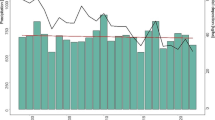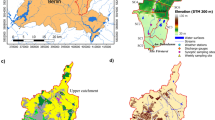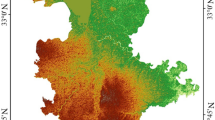Abstract
Urban stormwater runoff could have negative impacts on water resources and the environment. Rainwater Harvesting (RWH) can serve both as a stormwater control and water conservation measure. Cistern size and irrigation scheduling are two of the factors that directly impact the total runoff from a residential unit with a RWH system and the amount of potable water used for irrigation. The effectiveness of RWH was evaluated for four soil types; Sand, Sandy Loam, Loamy Sand, and Silty Clay, with a root zone of 15.2 cm using three irrigation scheduling methods (Evapotranspiration (ET)-based, soil moisture-based, and time-based), and five cistern sizes. Total runoff volumes and total supplemental potable water used were compared among the three irrigation scheduling systems and a control treatment without RWH. A model was developed to simulate the daily water balance for the treatments. Irrigation and runoff volumes were compared for the various scenarios. Silty clay soil resulted with 83 % more runoff than Sandy soil, while Sandy soil required on average 58 % more supplemental water than Silty Clay soil. On average, the 833 L cistern resulted with 41 % savings in water supply and 45 % reduction in total runoff. Results showed that the greatest volumes of runoff predicted were for the silty clay soil Control Treatment using a time-based irrigation scheduling method, while the least volumes calculated were for the sandy loam soil time-based irrigation scheduling treatment with 833 L cistern size. The greatest volumes of total supplemental water predicted were for sandy loam soil Control Treatment, while the least volumes were for silty clay soil ET-based irrigation scheduling treatment with 833 L cistern size. Regression equations were developed to allow for users to select a RWH cistern size based on the amount of water they want to save or runoff to reduce.




Similar content being viewed by others
References
Abdulla FA, Al-Shareef AW (2009) Roof rainwater harvesting systems for household water supply in Jordan. Desalination 243:195–207
Allen RG, Pereira LS, Raes D, Smith M. (1998) Crop evapotranspiration- guidelines for computing crop water requirements: FAO Irrigation and drainage paper 56. Rome: FAO–Food and Agriculture Organization of the United Nations;
CIMIS (2011) Irrigation scheduling. California Irrigation Management Information System. California, USA, http://www.cimis.water.ca.gov/cimis/infoIrrSchedule.jsp. Accessed 08 Mar 2011
Engelke MC, White RH, Colbaugh PF, Reinert JA, Marcum K, Ruemmele BA, Anderson SJ (2002) Registration of ‘crowne’ zoysiagrass. Crop Sci 42:303–304
EPA (2012) Water: green infrastructure. United States Environmental Protection Agency. USA: EPA.http://water.epa.gov/infrastructure/greeninfrastructure/index.cfm. Accessed 08 March 2012
Farahani H, Howell T, Shuttleworth W, Bausch WC (2007) Evapotranspiration: progress in measurement and modeling in agriculture. Am Soc Agric Biol Eng 50:1627–1638
Fengrui L, Cook S, Geballe GT, Burch WR Jr (2000) Rainwater harvesting agriculture: an integrated system for water management on rainfed land in china’s semiarid areas. J Hum Environ 29:477–483
Google (2011) Google earth. Google Inc. Mountain View, CA
Guo JCY (1999) Detention storage volume for small urban catchments. J Water Resour Plan Manag 125:380–382
Jones HG (2004) Irrigation scheduling: advantages and pitfalls of plant-based methods. Experimental Botany 55
Karpiscak MM, Foster KE, Schmidt N (1990) Residential water conservation: casa del agua. Water Res 26:939–948
Lee KT, Lee CD, Yang MS, Yu CC (2000) SW—soil and water: probabilistic design of storage capacity for rainwater cistern systems. J Agric Eng Res 77(3):343–348
MAPC (2009) Cisterns and rain barrels. Metropolitan Area Planning Council, Boston.http://www.mapc.org/regional_planning/LID/PDFs/Cisterns_web.pdf. Accessed 03 Mar 2009
Marek MA (2011) Hydraulic design manual. Texas Department of Transportation Texas. http://onlinemanuals.txdot.gov/txdotmanuals/hyd/index.htm. Accessed 20 Dec 2011
Mishra A, Adhikary AK, Panda SN (2008) Optimal size of auxiliary storage reservoir for rain water harvesting and better crop planning in a minor irrigation project. Water Resour Manag 2009:265–288
Montalto F, Behr C, Alfredo K, Wolf M, Arye M, Walsh M (2007) Rapid assessment of the cost-effectiveness of low impact development for CSO control Landscape and Urban Planning. 117–31
Morton TG, Gold AJ, Sullivan WM. (1988) Influence of overwatering and fertilization on nitrogen losses from home lawns. Environmental Quality 124–30
Muñoz-Carpena R, Dukes, M (2005) Automatic irrigation based on soil moisture for vegetable crops. Department of Agricultural and Biological Engineering, Florida Cooperative Extension Service, Institute of Food and Agricultural Sciences, University of Florida, Gainesville, FL. http://edis.ifas.ufl.edu/ae354
NOAA (2010) Dallas/Fort Worth climate overview. National Oceanic and Atmospheric Administration: NOAA. http://www.srh.noaa.gov/fwd/. Accessed 20 Mar 2010
NRC. Urban stormwater management in the United States. National Research Council (US). Washington, D.C: National Academies Press (U.S.); ISBN; 9780309125390 http://books.nap.edu/openbook.php?record_id=12465. 2009
Salvador R, Bautista-Capetillo C, Playan E (2011) Irrigation performance in private urban landscapes: a study case in Zaragoza (Spain). Landsc Urban Plan 2011:302–311
TexasET (2010) Texas historic weather averages. Texas A&M University, College Station, TX, http://texaset.tamu.edu/etinfo.php. Accessed 20 Dec 2010
Acknowledgments
The authors would like to thank the Texas Water Resources Institute and USGS, for providing the funds for this research.
Author information
Authors and Affiliations
Corresponding author
Rights and permissions
About this article
Cite this article
Shannak, S.A., Jaber, F.H. & Lesikar, B.J. Modeling the Effect of Cistern Size, Soil Type, and Irrigation Scheduling on Rainwater Harvesting as a Stormwater Control Measure. Water Resour Manage 28, 4219–4235 (2014). https://doi.org/10.1007/s11269-014-0740-x
Received:
Accepted:
Published:
Issue Date:
DOI: https://doi.org/10.1007/s11269-014-0740-x




